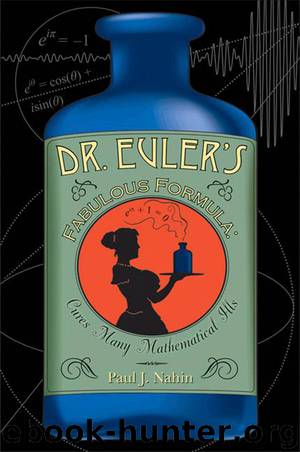Dr. Euler's Fabulous Formula by Nahin Paul J.;

Author:Nahin, Paul J.;
Language: eng
Format: epub
Publisher: Princeton University Press
Published: 2006-05-28T16:00:00+00:00
and explores what happens to them “mathematically” as T → ∞.
Perhaps “explore” is too gentle a word—what we’ll do is play with the two Fourier series equations in a pretty rough-and-ready way with little (if any) regard to justifying the manipulations. But—and this is important to understand—once we are done it won’t matter. Once we have the mathematical result that is our goal (i.e., the answer to “what happens as T → ∞?”) we can forget how we got it and simply treat it as a definition. The reason we can do this is because that result—called the Fourier integral—has deep physical significance, which is Nature’s way of telling us that, although we may have been a bit “casual” in getting to the result, the result is still a good result. Indeed, many books on the Fourier integral, written by mathematicians, take precisely this course of action.
Okay, let’s get started on seeing what happens as T → ∞. Notice first that the kω0 in the exponent of the ck integral changes by ω0 as k increases from one integer to the next. If we call this change Δω, then Δω = ω0. Now, since ω0 = 2π/T, as T → ∞ we see that ω0 → 0, that is, ω0 becomes arbitrarily small, and so we should write dω and not Δω as T → ∞, that is, as T → ∞ the change in the fundamental frequency becomes a differential change. Thus, for our first result, we have
Download
This site does not store any files on its server. We only index and link to content provided by other sites. Please contact the content providers to delete copyright contents if any and email us, we'll remove relevant links or contents immediately.
Modelling of Convective Heat and Mass Transfer in Rotating Flows by Igor V. Shevchuk(6222)
Weapons of Math Destruction by Cathy O'Neil(5828)
Factfulness: Ten Reasons We're Wrong About the World – and Why Things Are Better Than You Think by Hans Rosling(4487)
Descartes' Error by Antonio Damasio(3164)
A Mind For Numbers: How to Excel at Math and Science (Even If You Flunked Algebra) by Barbara Oakley(3103)
Factfulness_Ten Reasons We're Wrong About the World_and Why Things Are Better Than You Think by Hans Rosling(3046)
TCP IP by Todd Lammle(3011)
Applied Predictive Modeling by Max Kuhn & Kjell Johnson(2907)
Fooled by Randomness: The Hidden Role of Chance in Life and in the Markets by Nassim Nicholas Taleb(2860)
The Tyranny of Metrics by Jerry Z. Muller(2846)
The Book of Numbers by Peter Bentley(2779)
The Great Unknown by Marcus du Sautoy(2536)
Once Upon an Algorithm by Martin Erwig(2473)
Easy Algebra Step-by-Step by Sandra Luna McCune(2467)
Lady Luck by Kristen Ashley(2410)
Practical Guide To Principal Component Methods in R (Multivariate Analysis Book 2) by Alboukadel Kassambara(2379)
Police Exams Prep 2018-2019 by Kaplan Test Prep(2355)
All Things Reconsidered by Bill Thompson III(2261)
Linear Time-Invariant Systems, Behaviors and Modules by Ulrich Oberst & Martin Scheicher & Ingrid Scheicher(2231)
